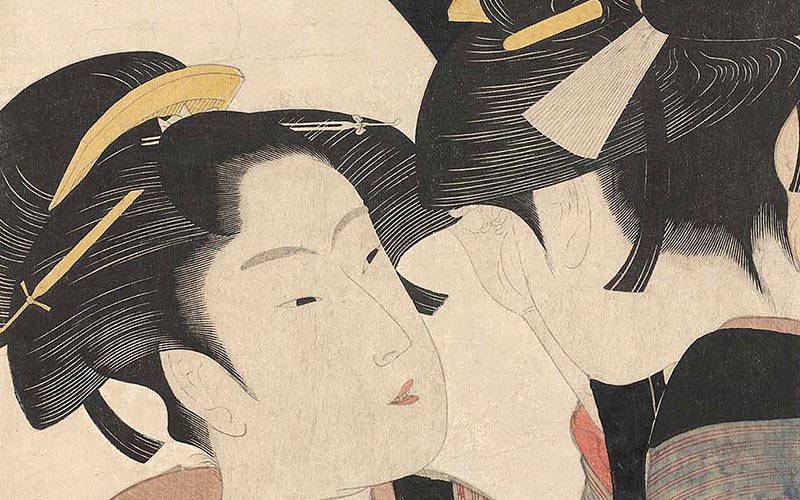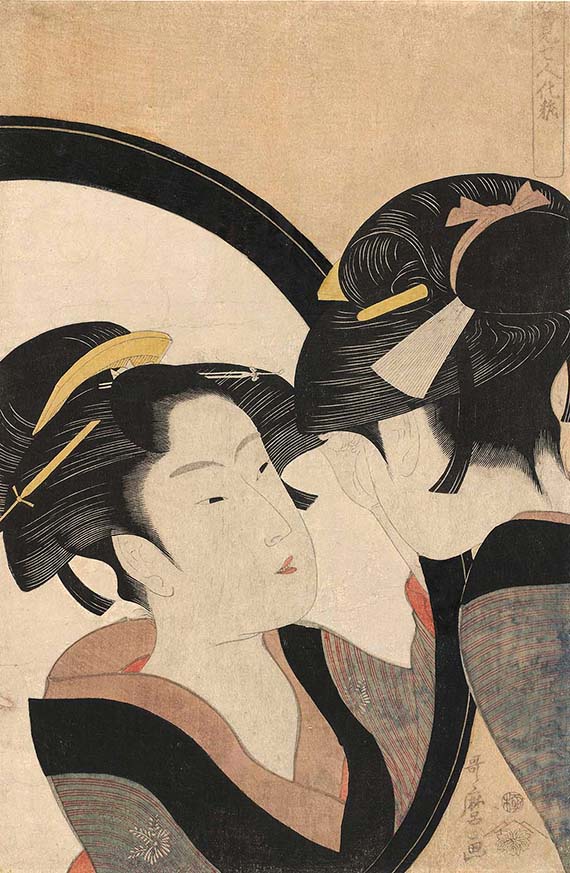
A dream of all women! Kitagawa Utamaro, Master of Beauty Paintings
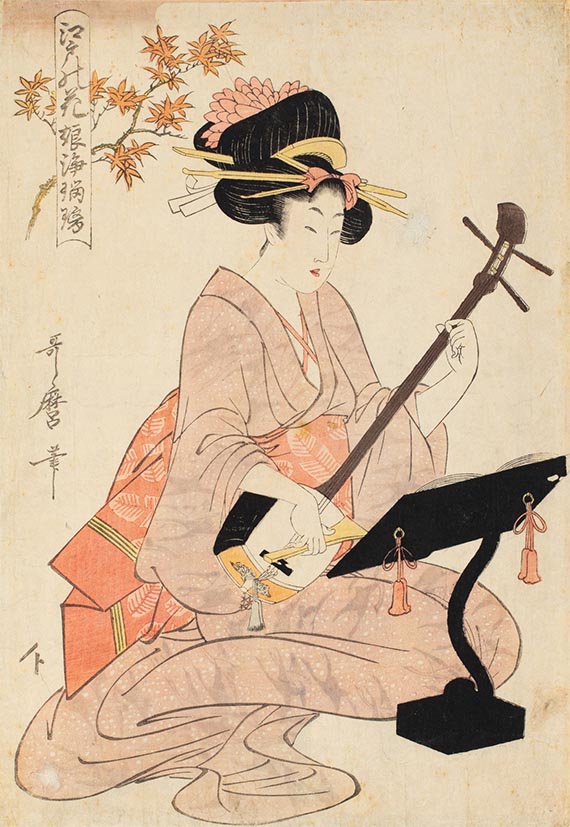
Kitagawa Utamaro was an Ukiyo-e artist active from the mid to late Edo period. Utamaro is known as a master of “Bijin-ga” (portraits of beautiful women), and established his own style by depicting beautiful gestures of women in a gorgeous and delicate manner.
Utamaro’s Ukiyo-e depict a variety of women as models, from commoners to prostitutes, but all women, no matter what class they belong to, are portrayed with great elegance. Combined with the beauty of the kimonos worn by the women models, Ukiyo-e by Utamaro became the object of admiration among the women in Edo.
Biography of Kitagawa Utamaro
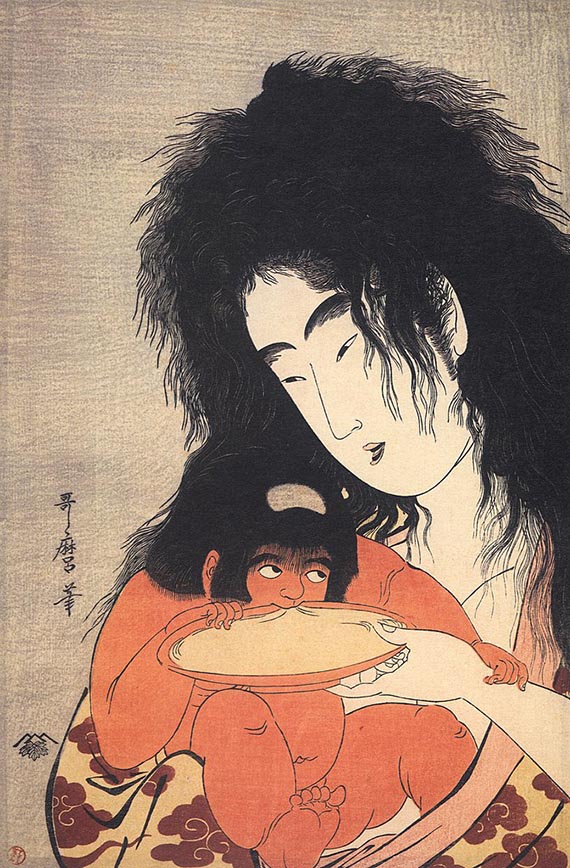
In 1753, Kitagawa Utamaro is said to have been born in downtown Edo (present-day Tokyo), but his actual birthplace is unknown. Utamaro, who became familiar with painting at an early age, began his formal training in painting under Toriyama Sekien, a town painter of the Kano school.
In 1770, Kitagawa Utamaro, who had been known as Kitagawa Toyoaki, made his debut in the art world with illustrations for the haiku book “Chiyonoharu”, and changed his name to the current “Utamaro” around 1781.
Around 1790, he began producing a series of paintings of “Bijin-ga” series, “Fujo Ninso Jippon” (Ten Types of Female Physiognomy) and “Fujin Sogaku Jittai” (The Ten Bodies of Women’s Studies). His works, which expressed the beauty of women through large neck paintings of beautiful women, became very popular in Edo (present-day Tokyo). Also known as a socialist, Utamaro also worked on genre paintings that incorporated the customs and culture of Edo.
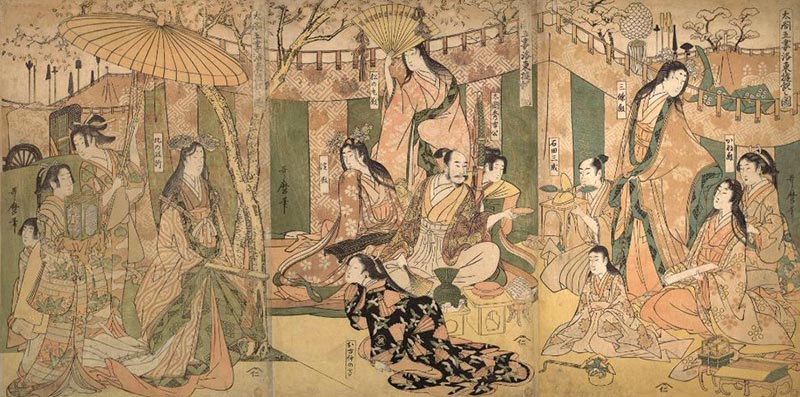
In 1804, when Kitagawa Utamaro published “Taiko Gosai Rakutou Yukan no Zu” (A View of the Pleasures of the Taiko and His Five Wives at Rakuto), this work was subject to the Edo shogunate’s “Kansei no kaikaku” (Kansei Reforms) and he was punished with a 50-day handcuff.
Utamaro died in 1806. The cause of his death is not clear, but it is believed to have been influenced by his punishment under the censorship of the shogunate.
Kitagawa Utamaro’s masterpiece
Kitagawa Utamaro “Young lady Blowing on a Poppin”
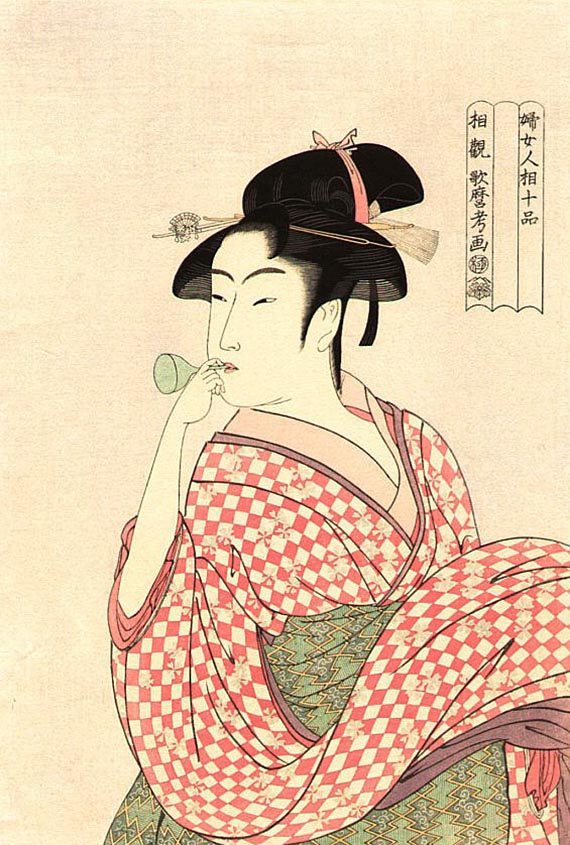
Kitagawa Utamaro’s “Poppin wo fuku onna” (Young lady blowing on a poppin) is one of a series of ten beautiful women’s paintings called “Fujo Ninso Jippon” (Ten Types of Female Physiognomy) and depicts a young town girl wearing a stylish kimono with a checkerboard pattern.
Utamaro’s “Poppin wo fuku onna” is a rare work with only a few copies in existence.
Kitagawa Utamaro “Ten physiognomic types of women, Coquettish type”
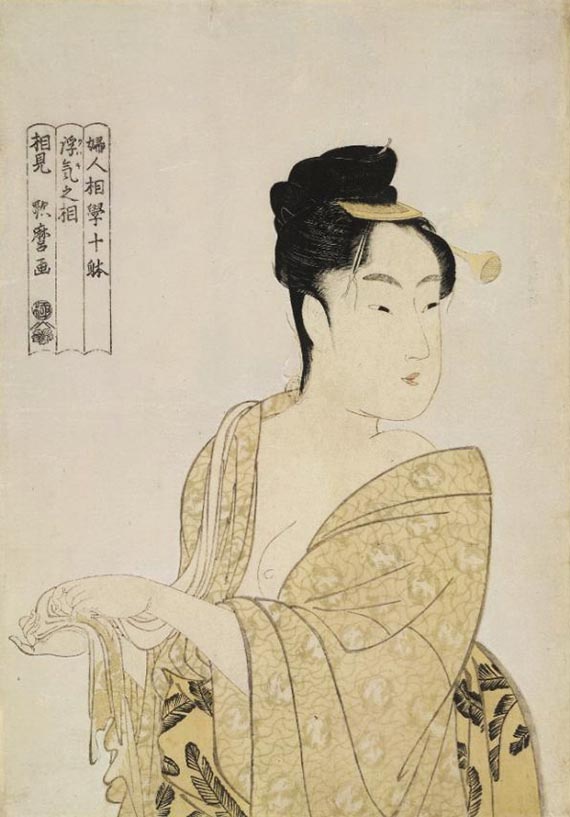
Kitagawa Utamaro’s “Fujin Sogaku Jittai Uwaki no So” (The Ten Bodies of Women’s Studies, Aspects Infidelity) is one of the “Fujin Sogaku Jittai” (The Ten Bodies of Women’s Studies) Ukiyo-e paintings produced at the same time as “Fujo Ninso Jippon” (Ten Types of Female Physiognomy). In “Fujin Sogaku Jittai Uwaki no So”, a woman wipes her hands after taking a bath while looking back, and her gesture and face express the character of a woman who has a strong interest in men.
Utamaro tried to depict not only the features of women’s faces and bodies and their external beauty, but also their inner lives through their gestures and facial expressions. The “Fujo Ninso Jippon” and the “Fujin Sogaku Jittai” series are examples of his attempts to depict the inner lives of women in his series of beauty paintings.
Kitagawa Utamaro “Three Beauties of the Present Day”
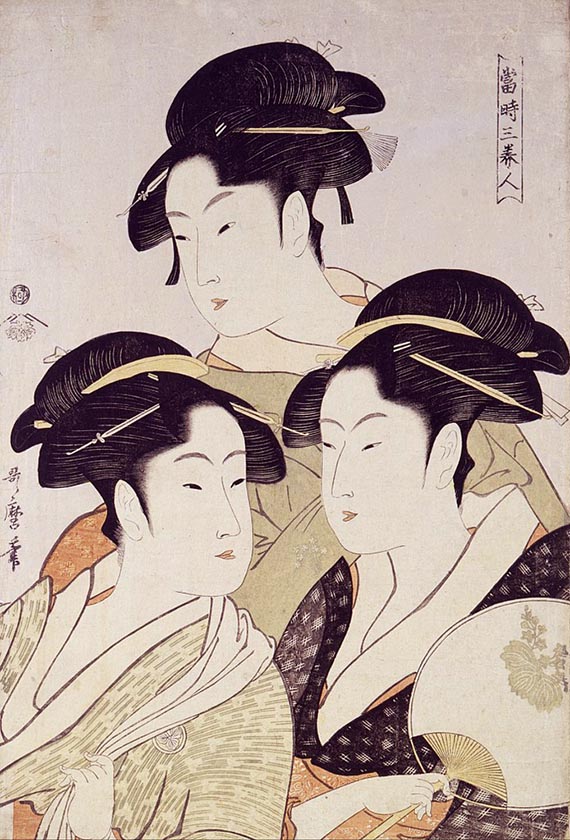
Kitagawa Utamaro’s “Kansei San Bijin” (Three Beauties of the Present Day) is an Ukiyo-e featuring three models who were reputed to be beautiful women in Edo during the Kansei era. From left to right, they are Takashimaya Ohisa, Tomimoto Toyohina (a Yoshiwara geisha), and Nambaya Okita. The mica-printed background enhances the glamour of the beauties.
“Kansei San Bijin” is the quintessential work of Utamaro, a master of “Bijin-ga”.
Popularity and Features of Kitagawa Utamaro
A sensitive portrayal of a woman’s inner life

One of the characteristics of Kitagawa Utamaro’s Ukiyo-e is their elegant and delicate depictions.
The women depicted by Utamaro are characterized by round eyes, thin and small lips, and beautifully combed hair. The face and body of the women seen through the comb and fan express the fragile glamour of them.
Bold large-necked paintings with outstanding beauty
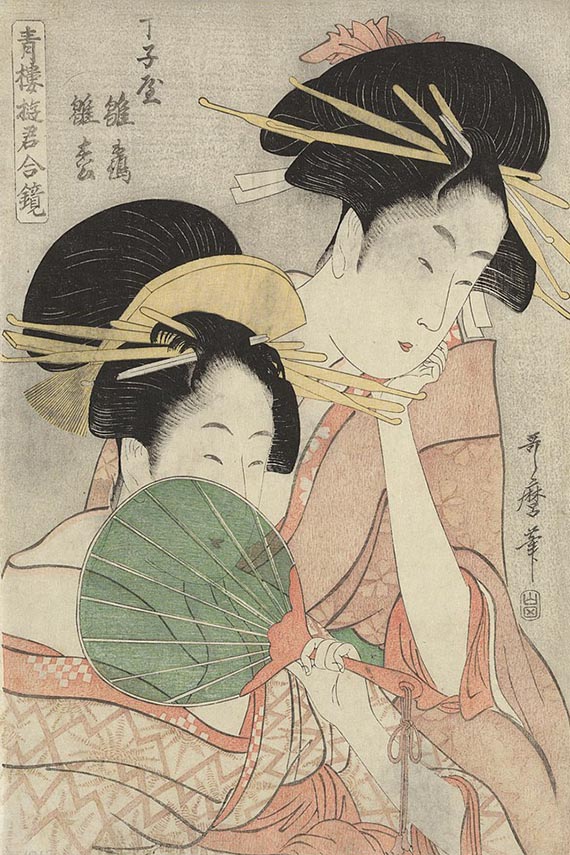
In Kitagawa Utamaro’s paintings of beautiful women, the compositions often show a cutout of the upper body or a close-up of the bust. These compositions are called “Okubi-e” (large-head pictures), and were often used in “Yakusha-e” (portraits of actors), which Utamaro incorporated into his paintings of beautiful women.
Utamaro studied women’s facial expressions and gestures in detail, and tried to express their inner personality, individuality, and emotions in his Ukiyo-e.
This characteristic is well illustrated in his “Bijin-ga” series, “Fujo Ninso Jippon” and “Fujin Sogaku Jittai”, in which women are divided into ten types based on their gestures and poses.
The latest fashion in Edo

Many women wearing beautiful kimonos appeared in Ukiyo-e by Kitagawa Utamaro, and they were the talk of the town for women in Edo at the time.
In the Edo period, when there were no photographs, Ukiyo-e by Utamaro, in which the latest kimono patterns and outfits could be seen, served the role of what we now call fashion magazines.
Techniques to Enhance Beauty
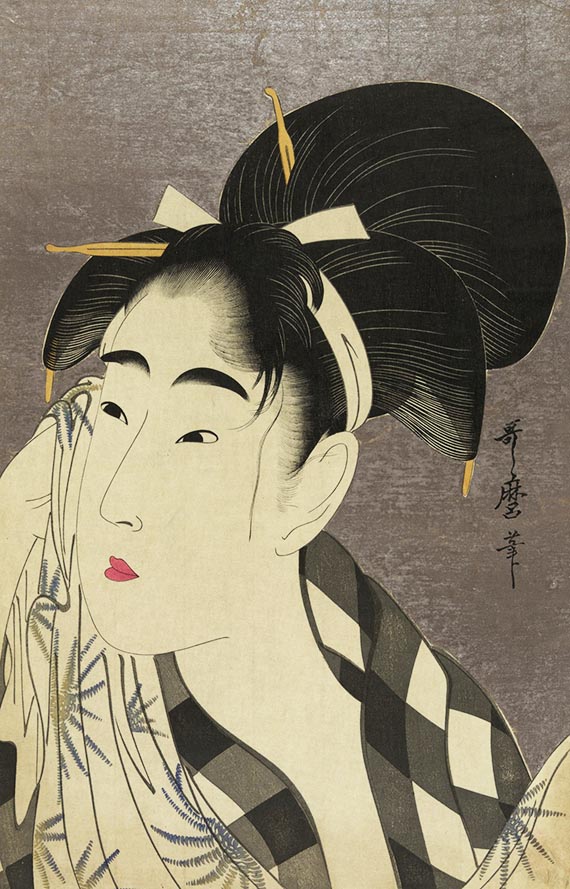
Kitagawa Utamaro incorporated various techniques into Ukiyo-e.
☆
Utamaro used “karazuri”, a technique in which rubs carved wood without color against paper to create shading, and “kirazuri”, a technique in which mixes mica powder with pigment (or sprinkles over wet pigment) to make the picture shiny. Then he created delicate kimono patterns and backgrounds that accentuate the models.
Evaluation and Influence on Kitagawa Utamaro
Kitagawa Utamaro’s reputation in Japan
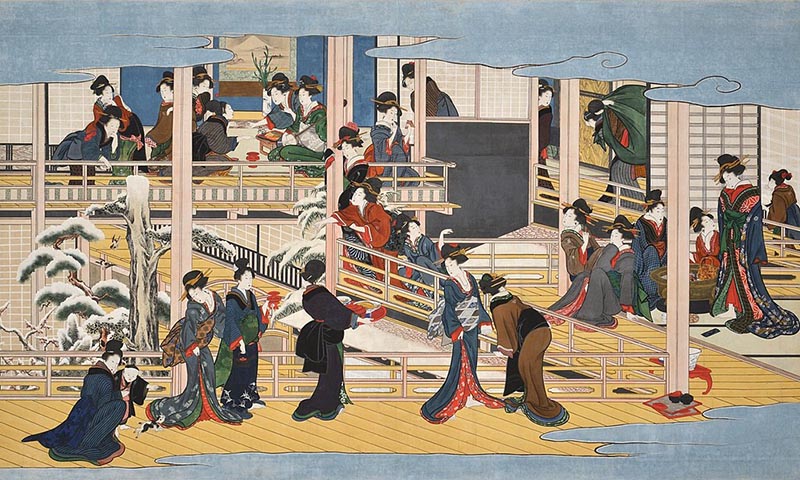
Kitagawa Utamaro’s Ukiyo-e artistry was highly acclaimed during the Edo period, and he had many disciples. Unfortunately, none of his disciples ever became as big a figure as Utamaro, but his techniques were passed on by his students.
Utamaro is one of Japan’s most famous Ukiyo-e artists and is highly regarded even today. Many art museums have collections of his highly artistic Ukiyo-e prints, including the Ota Memorial Museum of Art, the Okada Museum of Art, and the MOA Museum of Art in Japan, which also have his paintings in their collections.
Kitagawa Utamaro’s reputation abroad
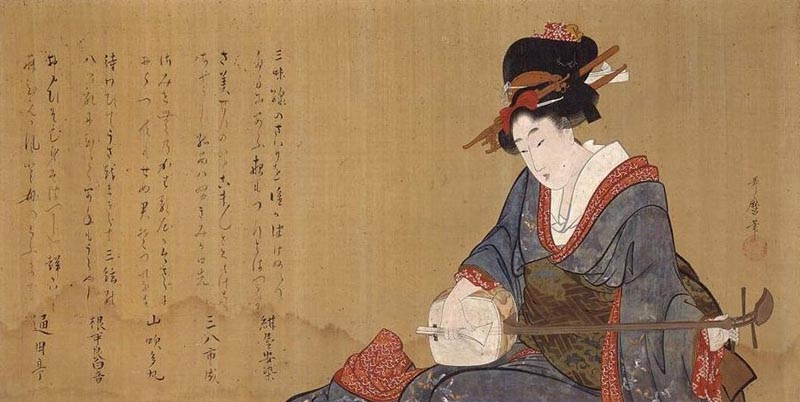
Ukiyo-e by Kitagawa Utamaro are highly acclaimed abroad, along with Ukiyo-e by Katsushika Hokusai and Utagawa Hiroshige.
The French writer and art critic Edmond de Goncourt regarded Utamaro as a genius Ukiyo-e artist on a par with Katsushika Hokusai, and in 1891 he published a book that he studied Utamaro. Edmond’s books were the forerunner of Japonism, the Japanese boom in France.
The Spalding Brothers, two of America’s richest men, are the most famous collectors of Kitagawa Utamaro’s Ukiyo-e. Of the 6500 pieces in the Spalding Brother’s collection of Ukiyo-e, just under 400 are by Kitagawa Utamaro. To prevent deterioration of the Ukiyo-e, the Spalding Collection is housed at the Museum of Fine Arts, Boston, and is not open to the public.
Rivals of Kitagawa Utamaro

One of Kitagawa Utamaro’s rivals was Eishi, who excelled at painting beautiful women.
Eishi was a unique Ukiyo-e artist who was born in Hatamoto, and was close in age to Utamaro, who was active at the same time in “Bijin-ga”. In contrast to Utamaro, who sold well with his “Okubi-e” (large head pictures), many of Eishi’s Ukiyo-e are characterized by full-length portraits of slender, tall women.
When discussing Kitagawa Utamaro, Harunobu Suzuki is often cited.
Suzuki Harunobu, who contributed to the birth of nishiki-e, gained popularity for his “Bijin-ga”. Many of Harunobu’s Ukiyo-e feature petite women, reminiscent of the influence of Chinese painting.
Summary of Kitagawa Utamaro
Ukiyo-e artist Kitagawa Utamaro established his own style of Ukiyo-e beauty paintings during the Edo period. He tried to express not only the graceful and elegant beauty of women, but also their inner beauty and emotions in Ukiyo-e.
The kimonos worn by the town girls and prostitutes in Utamaro’s paintings of beautiful women are highly valuable as materials for understanding the culture of the time.
Known as a socialist, his Ukiyo-e paintings teach us today not only about the beauty of women, but also about the customs and culture of the Edo period and how to live as a woman.
